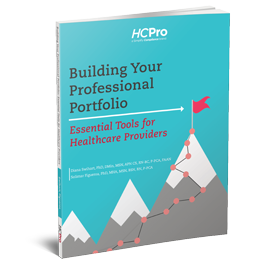Building Your Professional Portfolio: Essential Tools for Healthcare Providers
A master portfolio is a repository of YOU—your stories, artifacts, reflections, and progress through school and work. It is important to properly construct that story, especially when using it for your professional development. This book provides the guidance and framework to help you translate your education and work experience into the narrative that represents and defines you.
Reflecting the research and opinions of its authors, contributors, and advisors, the book offers guides, tips, and tools to help you create your master portfolio and adapt it for interviews, performance reviews, and targeted audiences. It includes portfolio models and format examples, organization and evaluation rubrics, and case studies of various approaches to portfolio building contributed by experts in U.S. and global communities.
When building your master portfolio, when and where do you start? What gaps, opportunities, and challenges do you want to explore? How do you best tell your story? This book will help you answer all of these questions.
This book will help you:
- Explore the evolving processes and decisions of building a portfolio
- Look at the purposes and types of portfolios, various terms and definitions, and the benefits of building, managing, and sustaining a portfolio
- Connect your artifacts and experience in a meaningful and purposeful way that will speak to your target audience
- Construct personal mission and vision statements to assist you with your academic and professional goals
- Celebrate yourself and all you have accomplished through your portfolio
Click here to access chapter previews.
Published: April 2019
Page count: 168
ISBN: 978-1-68308-851-6
Table of Contents
Chapter 1: The Importance of a Professional Portfolio
- Introduction
- Purpose and Types of Portfolios
- Defining Terms
- Benefits: Building, Managing, and Sustaining a Portfolio Is All About YOU!
- EXEMPLAR: Robert LaPointe, CNL
Chapter 2: Portfolio Conceptual Framework, Types, and Formats
- A Basic Conceptual Framework for Portfolios
- Where Does the Master Portfolio Come From?
- Portfolio Models and Formats
- Approaches in Identifying the Best Model for Your Portfolio
- Formatting Your Portfolio
- EXEMPLAR: Jose Irizarry
- EXEMPLAR: Kris Mela, Andrew Gash, & Ginger Gash
Chapter 3: Personal Mastery
- Reflective Narratives and Analyses
- EXEMPLAR: Jose Irizarry & Honoree Ceballos
- Legal and Ethical Consideration: Privacy, Confidentiality, and Disclosures
Chapter 4: Collecting Artifacts and Quality Evidence (Jose Irizarry)
- When and Where to Start
- Gaps, Opportunities, and Challenges
- How Do I Tell My Story?
- EXEMPLAR: Ruth E. Politi
- Organization and Presentation
- PEAKS: Collecting and Choosing Artifacts
- Selecting Quality Evidence
- Managing Artifacts and Evidences for Portfolios
Chapter 5: Bringing Your Portfolio Together (Honoree Ceballos)
- Portfolio for Self-Determination
- EXEMPLARS (5): Honoree Ceballos
- Mission and Vision Statements
- Portfolios to Communicate Competence
- Portfolios for Career Planning
Chapter 6: Making Connections: Narratives and Exemplars (Honoree Ceballos)
- Keep Your Materials Current
- Learn From Assessments and Feedback
- Power Up Your Career
- Communicate Your Effectiveness and Competence During Interviews
- Share Your Reflections and Exemplars
Chapter 7: Evaluating and Managing Your Professional Portfolio
- Exemplar: When Leaders Evaluate Your Portfolio
- Quality Evidence for Evaluating and Measuring Your Professional Portfolio
- Evaluation and Assessment
- Using Rubrics to Organize, Evaluate, and Manage Your Portfolio
Chapter 8: Case Studies and More Tools
- Case Study 1: Teaching Portfolios for Nurse Educators (Nuhad)
- Case Study 2: Upside-Down Portfolios for Professionals (Bryan Jones)
- Case Study 3: Professional Portfolios for Clinical Nurse Leaders(Robert LaPointe & Susan Ottenfeld)
Chapter 9: Wisdom, Recommendations, and Tips for Success
About the Authors
Diana Swihart, PhD, DMin, APN CS, RN-BC, P-PCA, FAAN, CEO and managing partner for the American Academy for Preceptor Advancement, enjoys many roles in her professional career, practicing in diverse clinical and nonclinical settings. An author, speaker, researcher, educator, mentor, and consultant, she holds graduate degrees in nursing and leadership and doctorates in theology and ministry. She has published and spoken internationally on nursing, shared governance, competency assessment, continuing nursing education, nursing and servant leadership, new employee orientation, professional nurse development, building effective preceptorships, and evidence-based practice in clinical settings.
During her career, Dr. Swihart has served as an American Nurses Credentialing Center (ANCC) Magnet Recognition Program® appraiser, a treasurer for the National Nursing Staff Development Organization (now the Association for Nursing Professional Development), and a commissioner on ANCC’s Commission on Accreditation. She currently serves as a consulting partner with the Forum for Shared Governance. In 2015, she was inducted into the American Academy of Nursing for her work in preceptor specialty practice and certification.
Solimar Figueroa, PhD, MHA, MSN, BSN, RN, P-PCA, has more than 30 years of professional nursing experience. Now a clinical educator II, her practice has encompassed the Philippines, the Kingdom of Saudi Arabia, and the states of Michigan and Florida. Dr. Figueroa’s experience includes roles such as perating room nurse, director of nursing, chief nursing officer, assistant director of nursing, and clinical educator. She also serves as a preceptor and mentor, roles that are very close to her heart.
Currently, Dr. Figueroa is a clinical nurse educator/preceptor liaison at Baptist Health South Florida. She has presented nationally on the “Married State Preceptorship Model,” a one-on-one preceptoring model she developed for new nurses transitioning into practice. The model was published in The Journal of Continuing Education in Nursing. She is also an ANCC appraiser. She holds a doctorate in nursing and master’s degrees in both nursing and healthcare administration.



 If for any reason you are not completely satisfied with an HCPro product, simply return it within 30 days of purchase and we will issue you a full refund.*
If for any reason you are not completely satisfied with an HCPro product, simply return it within 30 days of purchase and we will issue you a full refund.*